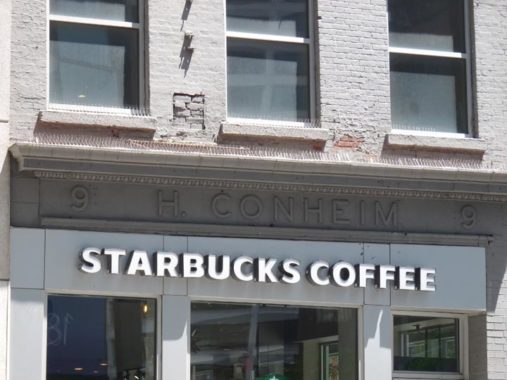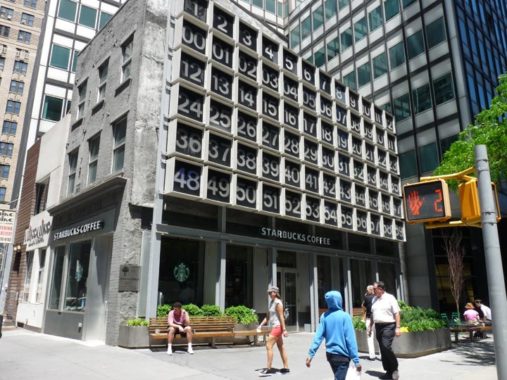I recently took a walk on the east-west streets in lower Manhattan looking for oddities and anachronisms. There aren’t many 19th-century buildings surviving on John Street in lower Manhattan, but you will find a pair of them, #133 and 135, on John Street just west of Water Street. This pair of buildings likely held offices of maritime trades that were located on nearby South Street and handled bills of lading. Perhaps the upper floors held residences. Most of these buildings were wiped out in the 1910s and 1920s when large office buildings went up on John Street, and some of those buildings were also demolished when the new wave of glassy towers began arriving in the 1980s.

In this 1940 photo #135 John Street appears in the center. The building only has three stories these days, so the top two floors have since been lopped off. The building on the right, #137, which housed the Fleet Oceanic Company, was torn down when Water Street was widened in the 1950s to accommodate extra traffic caused by the opening of the new Brooklyn-Battery Tunnel.

On the left, #133 still stands but has been reduced to two floors and is unrecognizable in comparison to the 1940 photo because of the modern signage.

#135 John Street was constructed in the mid-1800s for an H. Conheim, whose name is still emblazoned above the ground floor. The reason for the two “9”s on either side of the name are not immediately apparent to me unless John Street was renumbered at some time in the past. Today the numbers proceed east from Broadway.

#135 John Street is perhaps most famed for the digital clock designed by graphic designer and instructor Rudy de Harak (1924-2002). It was installed in 1971 as part of the building next door, 200 Water Street. The clock is 45×50′ tall and consists of 72 illuminated squares, the top row numbered 1 to 12 and the bottom squares numbered 00 to 59. When it worked the clock displayed the correct hour (the squares on top) minute and second, with the numbers flashing on every second from 00 through 59. Unfortunately the clock is no longer maintained, but perhaps some day, someone will get it working again.
Check out the ForgottenBook, take a look at the gift shop, and as always, “comment…as you see fit.”
5/28/19


12 comments
I believe 200 Water St was built by the same people who did 77 Water. 77 had an astroturf runway with a Sopwith Camel bi-plane sculpture made of plates welded to steel reinforcement rods. I snuck up on the roof to see it close up. In the lobby at 77 they had a soda machine covered in vinyl that would laugh when you put money in and stopped laughing when you made a selection.
Even though it’s no longer maintained, at least one box still works, the “2” at the lower right. Oh, wait.
I lived in 200 Water St between Feb 2016-Aug 2017 and the building undertook a renovation of the digital clock with new LED light panels. They tested the panels for months in the hallway of the building occupied by the laundry room until they were certain they would work once installed into the clock. And they did, for about a month, until they kept getting stuck or one specific number would light up and then not switch off. I guess they’ve since given up trying to get them working again, which is a shame because they looked amazing!
Here’s another pic which I think shows 9 Burling Slip. http://digitalcollections.nyhistory.org/islandora/object/nyhs%3A9470 . It’s a ca. 1890-1919 photo focused on McAleer’s Cafe, which appears to be at 88 South Street. If you look off to the left, you see a building labeled “National Paper and Type Company.” In the 1916 Atlas of the Borough of Manhattan, National Type Company is listed at 8 Burling Slip. So the building you see just to the left, labeled “____rdett & Dennis, might be #9, though I see a lot of refs to a Burdett & Dennis at *29* Burling Slip. The October 19, 1918 edition of the Real Estate Builders’ Record & Guide, page 460 (https://rerecord.library.columbia.edu/pdf_files/ldpd_7031148_062_42.pdf) notes that ##7 and 9 Burling Slip were sold for the first time in nearly 100 years that month. The buildings were then described as two four-story buildings. The RealtyShark website says 135 John Street (ex-#9 Burling Slip) was built in 1920. There’s a November, 1920 industry magazine that lists Conheim at 9 Burling Slip.
as best i see it 133 john st was in 1940 tax image 4 flirs and today 2 flrs and 135 john st was 5 flirs and down to 4 today, coner bldg cafe mcneer gone entirely altjough it seemsit 40s tax image it was still there as 4/5 stories before down for bk batt tunnel stuff.133 today before 7 burlingand 135 beofr e9burling that when mcneer bldge was still there as 4/5 story structure . of course as alot know burling is now john st and wjhere mcnee be is 200 south. i lifelong NYer and do this stuff qyite abit, this was a little tuffy presuming i got it righ ir almost right as it entailed bidgs gone or chaged extensively, bldg numbers chaged, stret names chaged, mayb more i mussed. in lower manhattan such as this nothing new when looking into this stuff. i.e. shearith israel i
1st sunagogue all speculation where it was when it as build (was wood) etc. and their cemteries they had in old NY wherein as far s i know they had 3 but 1 lost to history entirely ans 2 became 1 and 3 became 2 and 4 became 3 plus 3 i believe is in QUEENS. (hope facts on shearith israel are somewhat close)
Page 526 of the 1918 Polk directory (available from the NYPL) has Conheim at 70 1/2 Pine Street, but page 495 of the 1920-1 edition lists him at 9 Burling Slip. Along with that real estate record, I’m guessing that the sign, anyway, at 135 John dates from the 1918-1920 period, and most likely closer to 1920. It’s quite possible the building was either extensively renovated or totally rebuilt at that time.
From the Library of Congress online, Sanborn Map Company, 1890 – 1902 Vol. 1, 1894, ( http://hdl.loc.gov/loc.gmd/g3804nm.g3804nm_g06116189401 ) image 13. Burling Slip, eventually John Street, runs southeast from Pearl Street with the north side numbers going from 1 at Pearl to 11 (torn down) at Water Street.Voila Conheim #9
In 1972 I spent many miserable hours at 112 John St. collecting bad loan debts for Beneficial Finance Co.
I also spent miserable summer working at EPA possibly ’72 nearby because I needed money to attend college and my hi light was sitting at the chairs and platforms around this digital clock and watching the clock. There was a cool neon lighted tube in the building next to this that one walked through to where I don’t remember.
In the early 80’s, when the re-born South Street Seaport was in its touristy hayday, nearby the clock (around the corner?) was some outdoor restaurant(?) seating on wooden deck. There was a giant fish lure hanging with two triple-fish-hooks underneath. Hooks were probably about 10 feet high. If a person jumped well enough, they could grab onto a hook and hang. Not sure if it’s still there, or has swam away.
The clock is now working nicely! It’s fun to watch in action: The hour-number is in red, the minute-number in blue, and the seconds-number in green. Started a new job nearby, and while wandering around for lunch yesterday, had a chance to watch it for a bit. Wonder who calibrates it? Starbucks probably.
That building had a neon entrance leading to an elevator. Was shown in the video “Girls Just Want to Have Fun”. Cyndi Lauper is dancing in and out. It was much more interesting then.